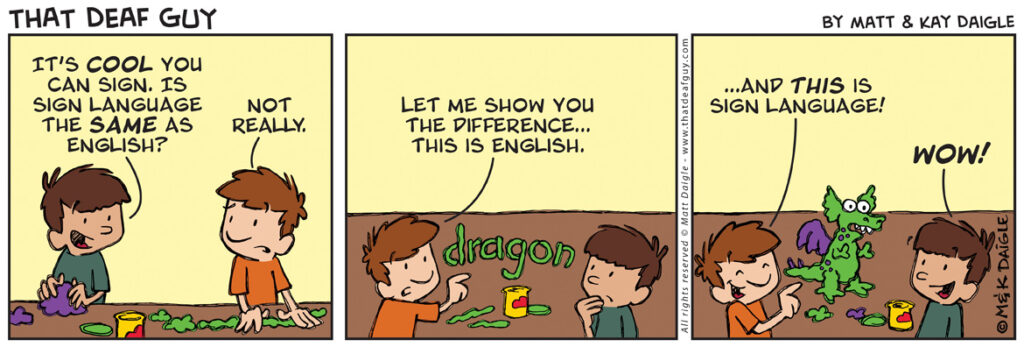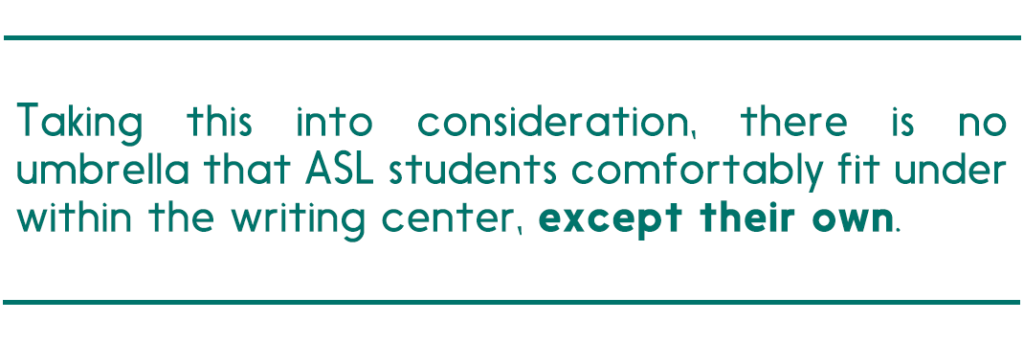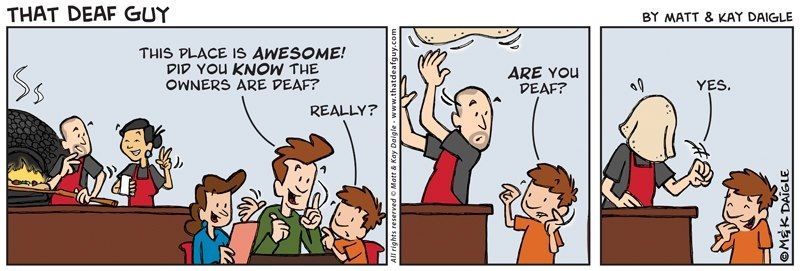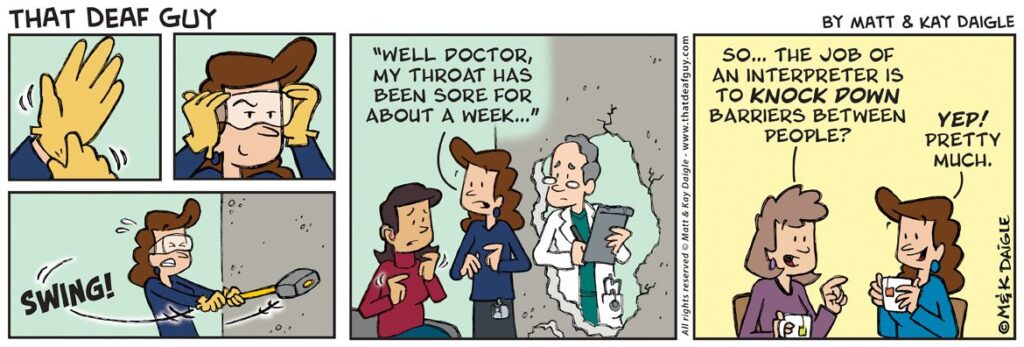By Natalie White, Western Michigan University
A good writing center aims to be accessible to all students, regardless of race, gender, sexual orientation or disability; however, many of the conventional methods passed down between centers are based on those without barriers to communication. This tutoring style leaves students who are d/Deaf or hard of hearing (HOH) in a complicated position. However, a great writing center not only sees where barriers lie, but actively works to deconstruct them, especially in a conversationally constrictive practice. In this post, I hope to bring to light some common misconceptions regarding d/Deaf students, consulting philosophy shift suggestions and overall useful tools to use in consultations with students with hearing disabilities. While the focus of these strategies is to promote a more accessible experience for d/Deaf students, many of these strategies may be useful for other disabled students. As such, I encourage readers to consider how these tools may be used in other writing center contexts.
Contextualizing deaf and Deaf students in the Writing Center
Throughout this paper, the term d/Deaf will be used. While deafness is an auditory disability, Deafness is also a culture. As such, the lowercase “deaf” refers to biological auditory deafness. The uppercase “Deaf” refers to the culture and norms of those who share and identify with auditory deafness. Only one in four people who are deaf are culturally Deaf (Babcock, 2005). For example, someone who was born hearing may have lost their hearing and be deaf but may not identify as Deaf. Additionally, it is crucial to understand each version of sign language has its own unique culture; this post encompasses research centering around American Sign Language (ASL) only. Lastly, in the writing center and in life, it is important to understand the distinction between d/Deaf but not appropriate to ask someone if they are culturally Deaf.

ASL has a largely different sentence construction pattern and does not use pronouns in the same sense as English (Schmidt, Bunse, Dalton, Perry, & Rau, 2009). Other common differences are lack of “to be” verbs, “missing” plurals and possessives and “missing” articles (Schmidt, Bunse, Dalton, Perry, & Rau, 2009).[1] These linguistic differences are helpful for tutors to understand when working with a d/Deaf students.
When working with d/Deaf or HOH students, tutors should expect and be ready for differences on a methodological level; for example, an interpreter may need to be used, agenda setting may look different, and/or extra time may be needed to reach the desired goals. In the next paragraphs, I will outline some reasons and suggestions for these shifts.
Misconception #1: ASL Students Can Be Treated as ESL Students
Fitting d/Deaf students into a previously conceived framework can be tempting, but also detrimental, especially when it comes to ASL. On the one hand, some writing center aficionados suggest that ASL learners should be regarded similarly to English as a Second Language (ESL) learners on the basis that ASL is its own language and English is a secondary, and different language (Cangiano, 1992). However, this distinction does not exactly fit, as d/Deaf students read and write in English but use ASL in their face-to-face communication. Therefore, both languages can be primary or secondary depending on the context.

On the other hand, some suggest ASL writers bear more similarity to Generation 1.5 learners, a concept explained by Matsuda and Cox, within the writing center. The concept describes writers fluent in the spoken aspect of a language, but not necessarily the written aspect (Matsuda & Cox, 2011). This categorization does not holistically apply as d/Deaf students grow up reading and writing in English, and are not submersed in spoken English as Generation 1.5 suggests.[2] Taking this into consideration, there is no umbrella that ASL students comfortably fit under within the writing center, except their own. I propose it is our duty to not simplify a complex and talented group of students to fit into our pre-structured philosophies, but rather put in the appropriate work to accommodate writers with hearing disabilities.
Misconception #2: High Order Concerns Are Prioritized over Low Order Concerns
It is crucial to understand there is no difference in the intellectual capacity of a d/Deaf student, rather a lack of proper and accessible instruction whether past or present. Deficits in learning stem from instruction or lack thereof in early childhood adolescence (Herring-Harrison, Gardner & Lovelace, 2007). However, due to the differences between ASL and English mentioned earlier, there are often deficits in grammar or low order concerns in consultations with students with hearing disabilities.
Taking this into consideration, d/Deaf students and HOH students may require more attention to grammar than hearing students; however this generalization reflects the prior education the student has received (Babcock, 2005). Babcock acknowledges that while writing centers traditionally try to work on higher order concerns (HOC), expectations should be shifted for these students to meet their needs that may not be fulfilled or well understood by other educators (Babcock, 2005).
Although, some seemingly LOC may stem from reading difficulties occasionally seen in d/Deaf students as the average deaf student graduates high school with a third to fifth grade reading level (Herring-Harrison, Gardner & Lovelace, 2007). When working with all students, regardless of hearing ability, reflection on whether the syntax issues are stemming from grammar understanding or source understanding is key. In order to truly help writers improve once they leave the writing center, writers’ issues should not be lumped into a larger group, but rather examined for the root of the misunderstanding.
Shifting Your Consulting Pedagogy
A large difference between consultations with hearing students and d/Deaf students should be the amount of clarity given when trying to lead the student through a thought process or to a suggestion. Normally, tutors work to be purposefully indirect with what they believe would improve the essay; however, ambiguity is looked down upon in Deaf culture (Schmidt, Bunse, Dalton, Perry, & Rau, 2009). Researchers (see Schmidt et al., 2009 & Babcock, 2005) agree that decreasing ambiguity when possible is beneficial to all parties when working with d/Deaf writers.[3] Tutors should aim to use short, clear sentences and avoid the use of jargon. For example, if a tutor wants to know what the writer is trying to communicate, it is better to say “I’m confused. What are you trying to say here?” instead of “This part seems a little confusing, let’s try to unpack it.” The directness of the first approach may seem blunt to hearing students but is appreciated by d/Deaf students and interpreters.
Additionally, with an interpreter, some tutors may be tempted to continue using the regular technique of reading a paper aloud and having it interpreted to the student. As is probably clear reading this (but not always in practice), this commonly used technique is not beneficial because of the structural differences between languages explained earlier, and the information overload on interpreter and student (Weaver, 1996). Furthermore, when reading sentences aloud to tweak grammar, tutors need to be conscientious to not point at specific parts of the sentence and speak at the same time (Babcock, 2005). While hearing tutees can read and listen simultaneously, d/Deaf students can only take in one visual signal at a time; thus, d/Deaf students cannot examine their sentence structure and also comprehend the interpreter’s signs at the same time. This concern may seem obvious, but in practice can be much more difficult to avoid.

For additional DOs and DON’Ts, please visit the slide presentation below:
Note that clicking on the three stacked dots on the frame for presentation will pull up an option to open speaker notes. These notes contain the alt text for the slides.
Concrete Tutoring Skills/Practices
One of the most important norms when consulting with an interpreter present is to make eye contact and communicate with the tutee and not the interpreter (Schmidt et al., 2009). When tutors communicate more frequently with the interpreter than the tutee, the tutee feels more isolated and uninvolved with the consultation than when the tutor makes the informed effort to communicate with the tutee almost entirely (Schmidt et al., 2009). With that being said, sometimes involving the third party beforehand helps to set up a cohesive workflow as interpreters’ abilities may differ.

In terms of writing practices that do work, research shows it is easier and beneficial for the tutee to brainstorm “out loud” in ASL, and for the tutor to take notes on what is communicated through an interpreter, than trying to have the tutee adjust to the tutor’s needs (Babcock, 2005). However, for this to work, the interpreter must feel comfortable translating longer sentences and/or pausing for interpretation. Premeditated discussions with the interpreter can help save the tutor and tutee time when it comes to the feasibility of these strategies.

Last, writing center administrators may wish to consider the benefits of computer-mediated writing sessions. The accessibility of closed captioning for HOH students and quick chat boxes while remaining face to face can help break down the barrier of finding an interpreter, especially on short notice. Students in research studies surrounding online accessibility stated these sessions felt more autonomous than in-person sessions with an interpreter and therefore more enjoyable (Carlson, 2004). It should be mentioned that this study focused on peer review with non-trained peers, and not on trained writing center consultants. However, it is my feeling the positive response from working with writing consultants should only improve with a culturally competent, well-trained tutor on the other end
Online tutoring sessions create more access for not only d/Deaf and HOH students, but also ESL writers, writers with limited access to physical spaces and a myriad of other writers with disabilities. The implementation of well-run online tutoring spaces promotes the universal design goal writing centers should be striving for.
Moving Forward
Further research absolutely needs to be done on how to increase d/Deaf and HOH student utilization of writing centers, not just how to accommodate them once they are there. Without creating an inviting space for these writers, there will be no progress in writing center strategies. In order to reach d/Deaf and HOH students, I believe partnering with student services and d/Deaf or disability advocacy groups on campuses will be the most effective route. It is my hope the strategies given above will continue to evolve and change with input from writers, and eventually d/Deaf tutors as well.
Notes
[1] Furthermore, words that are important to those who write in English, such as the word “author,” may be absent in ASL vocabulary (Weaver, 1996). In ASL, “author” would be communicated as a compound between “write” and “person.”
[2] Additionally, Matsuda and Cox point out that previous education in English plays a large role in the current level of proficiency (2011). If a student attended an all deaf school where communicating in English was not as necessary, they may have a different level of English than a student who previously needed to assimilate into an English hearing context.
[3] This finding also extends to the source text. One of the students profiled in Rebecca Babcock’s “Tell Me How it Reads” described that texts that were lengthy and vague were more difficult than direct texts or texts with supporting visuals. For example, a convoluted article about theory may be more difficult than a newspaper article.
The featured photo for this post was taken on April 7, 2018, on Shoreham Street, Sheffield by Tim Dennell and depicts part of the exhibition “IMAGINE – in sign language” by Korean artist Hun-Joo Koo (a.k.a. KAY 2), which was part of an artist exchange between Sheffield and Busan.
Works Cited
Babcock, R. D. (2005). Tutoring deaf college students in the writing center (Order No. 3167231). Available from ProQuest Dissertations & Theses Global. (305375376). Retrieved from https://proxy.lib.umich.edu/login?url=https://search.proquest.com/docview/305375376?accountid=14667
Cangiano, V. J. (1992). Bilingual and ESL approaches to deaf education: perspectives on the reading process. Hunter College .
Carlson, H. O. (2004). Computer-mediated writing development in postsecondary students who are deaf (Order No. 3152870). Available from ProQuest Dissertations & Theses Global. (305121791). Retrieved from https://proxy.lib.umich.edu/login?url=https://search-proquest-com.proxy.lib.umich.edu/docview/305121791?accountid=14667
Herring-Harrison, T. J., Gardner, R., & Lovelace, T. S. (2007). Adapting Peer Tutoring for Learners Who Are Deaf or Hard of Hearing. Intervention in School and Clinic, 43(2), 82–87. https://doi.org/10.1177/10534512070430020801
Ladd, D. P. (2003). Understanding deaf culture : In search of deafhood. Retrieved from https://ebookcentral.proquest.com
Matsuda, P. K., & Cox, M. (2011). Reading an ESL Writer’s Text. Studies in Self-Access Learning, 4–14.
Schmidt, K., Bunse, M., Dalton, K., Perry, N., & Rau, K. (2009). Lessening the divide: strategies for promoting effective communication between hearing consultants and deaf student-writers. Writing Lab Newsletter, 33(5), 6–6.
Weaver, M. E. (1996). Transcending “Conversing”: A Deaf Student in the Writing Center. Journal of Advanced Composition, 16(2), 241–251. Retrieved from https://www.jstor.org/stable/20866077

Natalie White is a rising first-year medical student attending Western Michigan’s Homer Stryker School of Medicine. She takes a special interest in disability advocacy in all settings, and hopes to continue this passion into her career. In her free time, she enjoys reading, baking and watching any University of Michigan sporting event. Go Blue!


That was a very informative article. Absolutely loved reading the post. It helped me a lot to understand social media marketing. Thanks for sharing.
Thank you for this post, Natalie! I’m so appreciative for these insights into ASL linguistic patterns, for your clear differentiation between deafness as auditory disability and Deafness as culture, and of course for the concrete tutoring practices. Here at UW, we’ve been working on making our WC more accessible, and your post sheds light on where we can be more intentional in connecting with d/Deaf and HOH writers on campus. I look forward to discussing this piece with our incoming cohort of new Writing Center instructors!